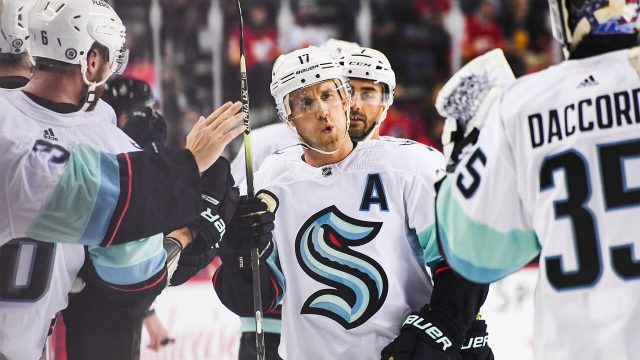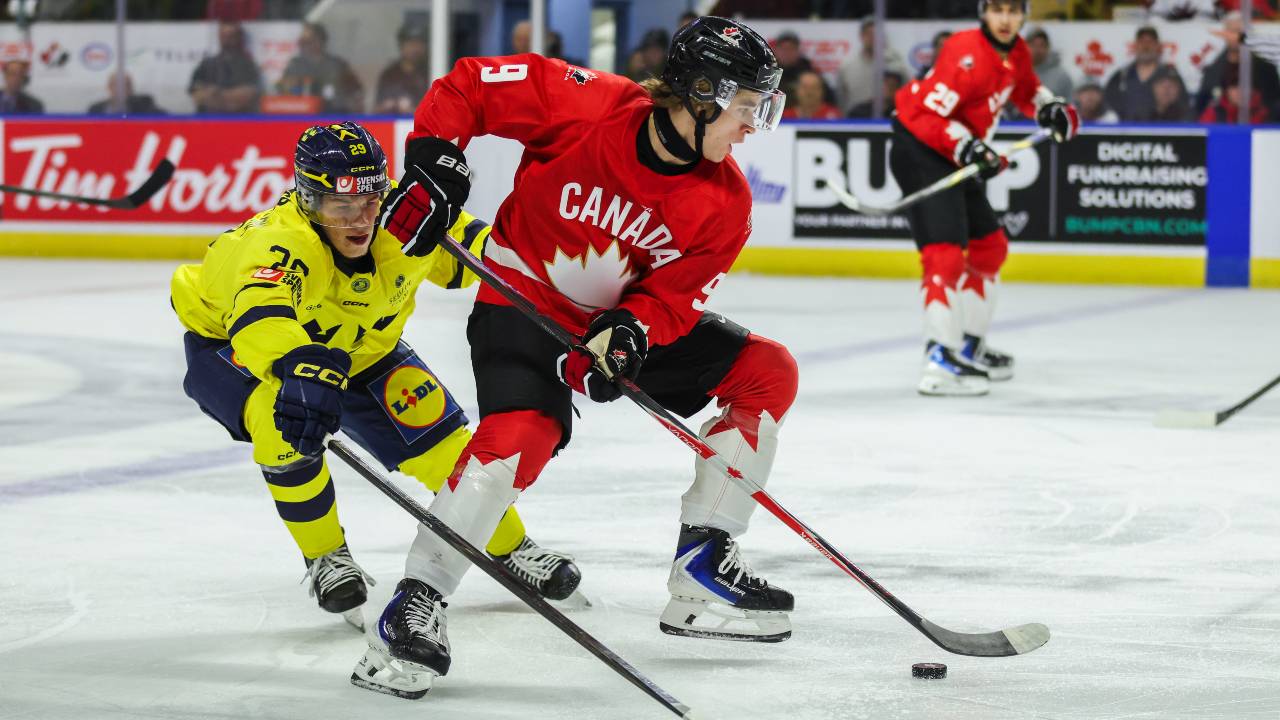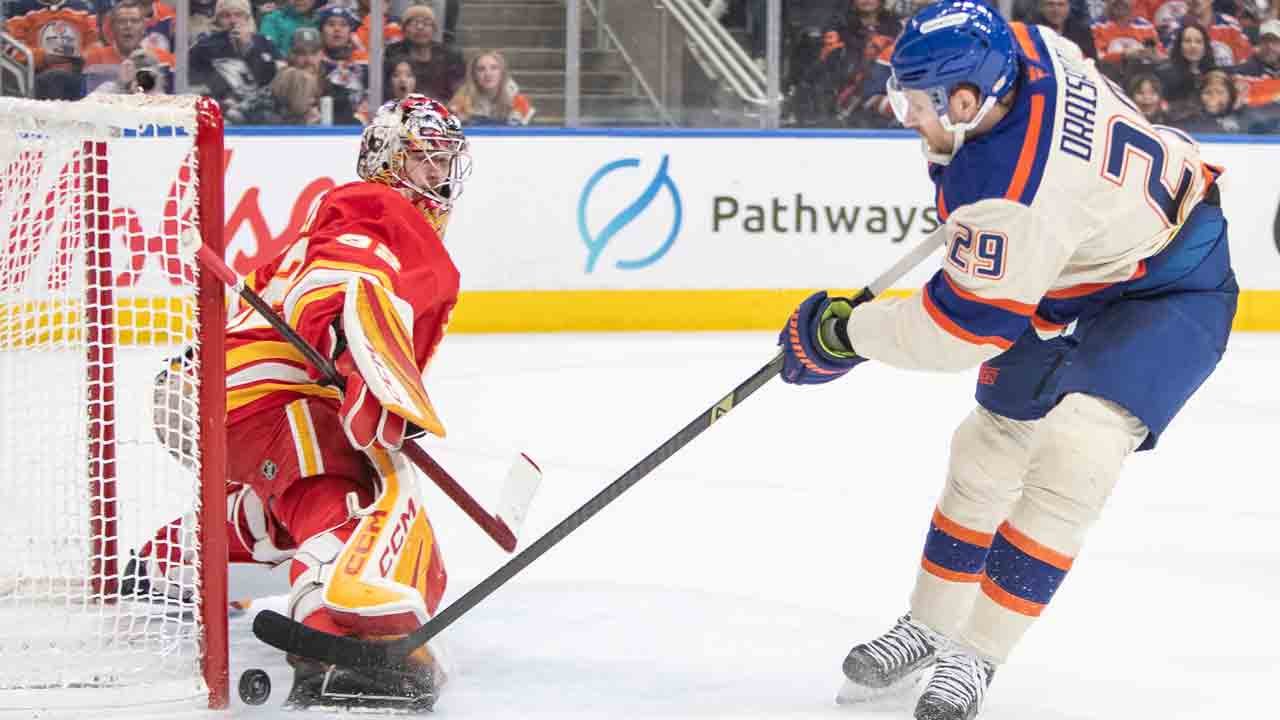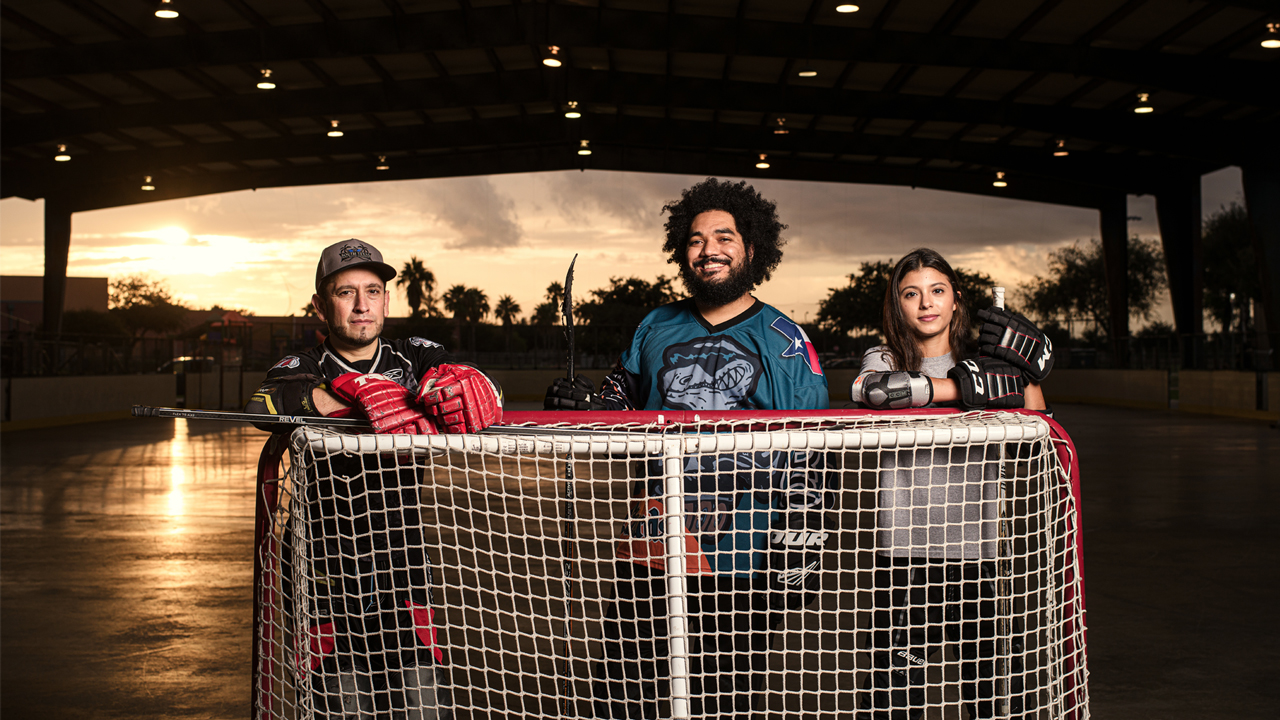
THE STICKS, THE ACCESS, THE FUTURE
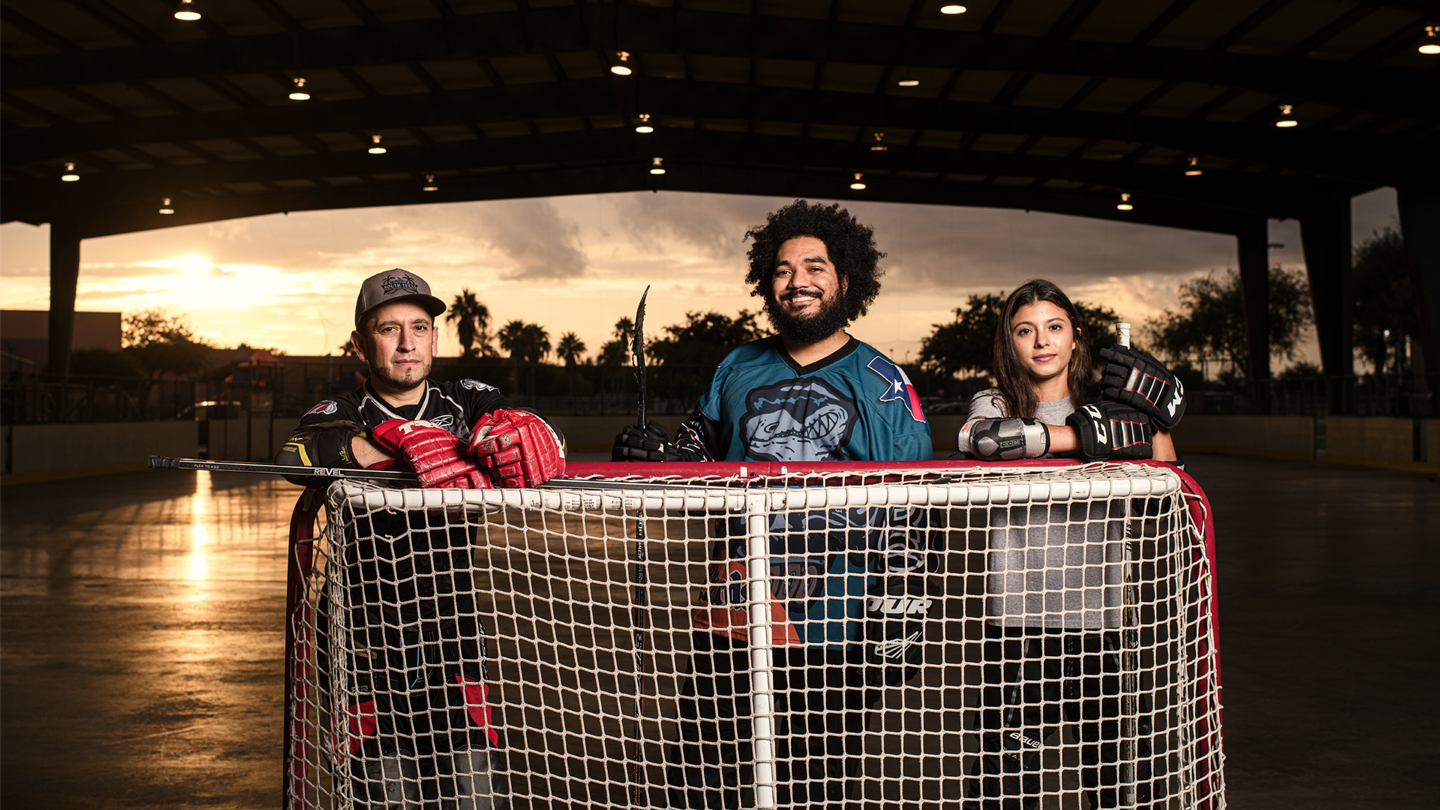
J
uan Pablo Lopez has made this journey south from Progreso so many times, he’s got it colour-coded by month. Hit the eight-mile shot down to the Mexican border in September and the fields bordering Highway 281 glow white in the heat of the Texas morning, miles of cotton like freshly fallen snow floating above the sun-baked leaves. In October or November, it’s the deep red of the sorghum that crowds the asphalt on both sides, and by April, the corn crops’ neatly lined bands of green run alongside you. It’s the latter flying past the windows of Lopez’s old Volvo wagon now as he approaches the Donna-Rio Bravo International Bridge.
Arriving at the border, the calm of open fields and blue skies is interrupted by silver gates, barbed wire, orange pylons and weighty barriers, funnelling traffic toward cameras and floodlights — the familiar paraphernalia of American displays of power. But when Lopez pulls up to the agent waiting for him at the window, the conversation is less formal than the mess of concrete might suggest. Staring with undisguised curiosity at the mass of gear stuffed into the back of Lopez’s car, the agent simply cracks a smile: “Really?”
On past journeys, coworkers have been called over with a laugh, Lopez’s frequent crossings an inside joke among the border agents. Some have even asked if they can join him after first catching sight of the gear.
Eventually, the wagon lurches off American pavement and into Tamaulipas, the Mexican state lying south of Texas along the Gulf Coast, Lopez crossing from one half of the Rio Grande Valley into the other. From the border, it’s another seven miles to his final destination in Rio Bravo. On the way, he stops at his mother’s house, these trips his only opportunity to visit. She insists he eat before he leaves, as she always does, hoping to fortify her son before an afternoon in the oppressive heat. But Lopez’s anticipation outweighs his hunger, and soon he’s on the road again.
After winding through Rio Bravo’s bustling streets, he finally parks the wagon and steps out with butterflies in his stomach. He retrieves his gear from the trunk, and pauses for a moment, just to take in the sight of it. There, nestled amid a crown of lush green trees, encased in an oval of sky-blue concrete that delineates where town ends and oasis begins: a hockey rink.
Laying his gear down at the rink’s edge, Lopez crosses over the faceoff circle and climbs up into the grandstand to look out over the concrete paradise. It’s hardly his first viewing. The 42-year-old has been coming here nearly every weekend for more than two decades, since back when it was first opened as a futsal park and he and his friends quickly sealed its fate by covering the goals at each end and dropping hockey nets in their place. Even then, his love for the game was already well-established. As a teenager Lopez was so addicted his mother once followed him around town because she refused to believe the reason her son was coming home late every night was because he’d devoted himself to this strange sport. She relented after finding him roller-skating by himself, wiring pucks into a net at 11 p.m.
He’s doing the same this afternoon as the usual cast of characters filters in for game time and sets up by the boards. Soon after, the puck finally drops, and in that moment, it’s all worth it. So deep is Lopez’s love of hockey, the weekly 30-mile journey across the border to Rio Bravo is a small price to pay for these games — for the chance to show off his silky hands; the chance to set up behind the net, flip the puck onto his blade and hit netminder Javier with his own iteration of The Michigan Goal.
Hidden away in Tamaulipas, a small but dedicated hockey community has been hitting the pavement for games like this for years. And on the other side of the Valley, Lopez and fellow hockey lover Nathaniel Mata are hoping to tap into the same model that nurtured that passion, to build upon what Mexico already has and help the game flourish across the border, as well. But after seeing once-loved teams leave town, after seeing the area’s only ice rink shut down by the pandemic, hockey is hanging on by a thread in south Texas. Now, Lopez, Mata and their non-profit, RGV Roller, have aligned to reignite interest in the sport, fight for its place in the Valley, and offer the hockey world a blueprint for how to grow the game even in the unlikeliest of locales.

T
hough Nathaniel Mata’s love for the game flourished in the Valley, he was first introduced to hockey in California. Born in San Jose a few years after the excitement of the Sharks’ arrival in the Bay Area, Mata got one glorious year enrolled in ice hockey as a five-year-old, after his parents came across sign-up sheets at the mall and decided to take the plunge. But the cost quickly proved too great for his family to justify, despite young Mata’s already-blooming affinity for the sport. “I wasn’t an only child anymore, I had a couple of siblings, so it was just a little too pricey for my parents,” he says. “I think that’s a story that a lot of people might not realize is pretty common, parents not being able to let their kids continue a sport that can cost so much money.” He switched to basketball, baseball and other less expensive sports, wishing for another shot on the ice that never came.
A few years later, the family relocated to the Valley’s McAllen, Texas, and the dream seemed to fly completely out the window. While the state boasted its own NHL club at that point, the bright lights of the Dallas Stars’ American Airlines Center faded long before they reached Mata’s hometown seven-and-a-half hours south. He eventually found one brief glimmer of hope, stumbling upon a beautiful, city-owned outdoor roller rink, complete with stands and a pavilion roof to blunt the Texas heat. But the opportunity to play didn’t extend much further than the presence of brick and mortar. “There was one point that the city said, ‘Okay, we’re going to have [a program where]kids learn to play hockey,’ and I signed up,” Mata says, remembering his 10-year-old self’s excitement. “I went, and nobody was there. The city didn’t show up, there was no coach. My mom took me. I was so heartbroken.”
It was the sting of that disappointment, and a couple decades of struggle to keep up his fandom in his mostly hockey-less corner of Texas, that spurred Mata — RGV Roller’s president — to put the organization’s wheels into motion in September 2019. By that point, he’d found his way back to the game. After years of trying to nudge neighbours into giving the sport a try, Mata eventually came across Lopez and his fellow Tamaulipas expats playing at that same McAllen rink. He went out, bought some roller skates, and decided to dive in. It wasn’t quite the on-ice dream he’d once had in California — it was something different, and it was glorious. But even with his own desire to play finally satisfied, Mata couldn’t shake the need to ensure other kids in south Texas didn’t have to endure a similar years-long wait just to find a game.
He saw only one solution. “The way to grow the sport is with youth and it’s with kids and it’s with making the sport affordable,” Mata says. So, he went to work plotting out his vision for a Valley hockey youth movement. He brought together those on the scene who also seemed to see the importance of involving the next generation, assembling a board that reflected both sides of the Valley’s hockey experience. “I think I come with an interesting perspective to RGV Roller, because a couple of the people on our board are people that have played hockey a lot of their life, and I’m someone who has loved hockey my entire life, but I didn’t really get to play,” he says. “I pour my heart and soul into this, because I feel like I was deprived of this great sport for so long.”
Jacqueline Arias joined the budding project as a board member soon after. She and Mata had met while working for their university paper, often sitting in the stands of the McAllen rink in those days talking about how they wished hockey had a greater presence in their town. Arias brought with her the perspective of someone who had grown up with even less of a connection to the sport, its total absence from her younger days fostering a deeper understanding of the barriers RGV Roller would need to navigate. “I grew up in Donna, Texas, and it’s a pretty poor community,” Arias says. “For us, it’s pretty hard to get access to pretty expensive sports. It’s not really in our high schools or anything like that. So, for me, it’s, how do we get people like me, who grew up in a poor community, people in colonias, those communities who have been harder hit, to get involved in the sport? How do we provide that avenue?”
The first step was simply access. In January 2020, RGV Roller officially announced itself to the south Texas community with a cookout and a free session at that rink in McAllen. Sticks were available for kids to pick up and try out, to get a tangible feel for what the sport’s all about. Looking back on his own introduction to the game, and at Arias’s, Mata felt putting sticks in hands was key. “If you experience [hockey], it’s so much different than if you just watch it,” he says. “You’re doing something that’s foreign — it’s not just dribbling a basketball, it’s not just swinging a bat. If you’re Canadian, maybe it feels like it’s a part of your DNA, but I mean, for me, it was really different. And I think for a lot of people down here, it still is different. But it’s so much fun.”
The first few months of 2020 saw early signs of life. That January event drew a crowd of 50, more than they’d expected for their low-key debut. Momentum continued to pick up at a second event the next month, young parents from the area flocking to the rink, eager to find out when they’d be able to sign their kids up. “We had a really good community turnout, just parents on Facebook finding our event, that never knew about hockey either,” Arias remembers. “And their kids loved it.”
Joe Haske, who’s played with Lopez for years since moving to the Valley from Michigan, remembers feeling the community’s attention shift. “We were playing on some of the basketball courts when we couldn’t play anywhere else, and a lot of kids would stop and watch us,” he says. “They’d take their parents over and wanted to see us playing. Their parents would ask how they could get their kids involved. They wanted to get to the rink and play.”
“That was right before the pandemic hit,” says Arias. “We really thought we were so close. 2020 was supposed to be the year that we kicked off everything. We were hoping to do summer camps for kids. [Lopez] is a teacher and a coach, so we were ready to start those big camps. But, yeah, the pandemic.”
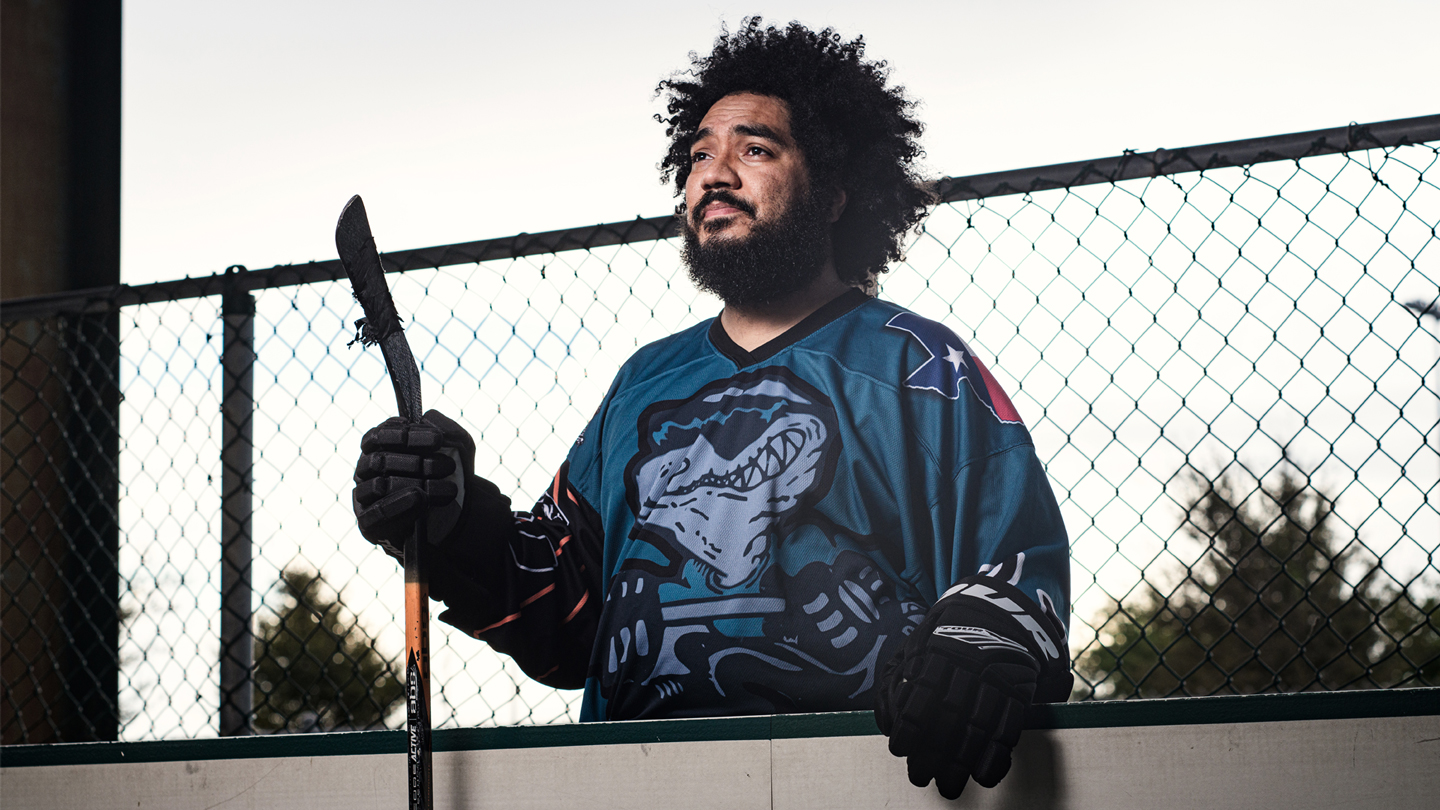
T
he roots of RGV Roller’s fight to grow the game on the American side of the Valley start across the Rio Grande, 35 miles west of McAllen, in Diaz Ordaz. The border town is tiny — one long road runs its length, with a handful of smaller ones branching off only about a mile in each direction — but ask anyone who knows their way around the Mexican hockey scene, and they’ll tell you of the legacy of that hidden gem. For years, players from across the Valley could head to the very end of that main road and find a rink there at the town’s edge. And in that rink, more often than not, they’d find The Doctor, one of the country’s greatest hockey coaches, who built one of the country’s greatest hockey programs. The Rio Bravo clan, the McAllen effort, RGV Roller — it all traces back to the end of that road in Diaz Ordaz, to The Doctor.
It was late 1992 when the seed was first planted in Diaz Ordaz. Dr. Juan Carlos Hernandez and his son, Miguel, found themselves hooked by a silver-screen classic called The Mighty Ducks. A source of lovable nostalgia in Canada, the film’s impact on hockey in the Valley was more profound, sparking a wave of kids running around with brooms imitating slap shots and slow-motion dekes. For Miguel and his cousins, a greater love for the sport bloomed when The Doctor replaced those brooms with sticks and roller skates, and started coaching the kids in his backyard. An hour away, in Rio Bravo, Lopez and his childhood friends had begun taking to a basketball court at a local church, trying to figure out the sport for themselves, too.
That early interest grew slowly and steadily in both towns for a few years, until Lopez heard word of what was going on in Diaz Ordaz from his father, who worked at a local hospital with The Doctor. In 1996, Lopez — by then a hockey-obsessed teenager — started travelling to Diaz Ordaz with his friends every weekend, taking a bus to go visit The Doctor and his growing crop of young players. The visits opened up a whole new world for Lopez and his band of Rio Bravo puck lovers. It expanded their community and granted them the experience of playing for a coach just like in the film — a Gordon Bombay for these young Charlie Conways. The uptick in players only meant more hours poured in by The Doctor, who eventually moved his coaching from the backyard to a nearby basketball court, and then to a local futsal facility.
As it turned out, enough kids in enough towns throughout Mexico had picked up roller hockey in the years since The Mighty Ducks’ arrival that in ’96, a tournament was launched, bringing together teams from every state. It was there that The Doctor’s squad became the stuff of local legend. In the second year of the tournament, the Diaz Ordaz crew entered representing Tamaulipas. They wound up claiming a gold medal, starting a run that saw Tamaulipas finish as the country’s best for more than a decade straight. So dominant was the team from that tiny border town that Diaz Ordaz was selected as the site of the country’s first proper roller hockey rink, built at the end of that main road in the late ’90s.
Ask Lopez or any others on that Tamaulipas team what it was that allowed them to put together their sterling run, and the answer is always the same: The Doctor. “He might’ve not been the biggest expert in hockey but he was a very good leader,” explains Bruno Arjona, who was part of the next wave of kids to train with The Doctor, his first trip to the Diaz Ordaz rink in 2006, at age 11. “He tried to learn as much about hockey as possible, soak it in, and then in his own way, teach us what he learned.”
Unconventional as the method was, it allowed a small-town kid like Arjona access to big dreams. Weekends in Diaz Ordaz eventually turned into a trip to the AAU Junior Olympic Games, to represent Mexico. Soon after came two roller world championships, and then four Division III world junior championships with Mexico’s national ice hockey team. “I’ve worked with a lot of coaches during my years, and a lot of coaches … [who]have played some very high-level hockey and that definitely know hockey more than him,” Arjona says of The Doctor, “but he’s the best coach I’ve ever had.”
The legacy of that humble dream factory in Diaz Ordaz has been far-reaching. The Doctor’s program became a feeder for the Mexican national teams, granting others like Arjona the chance to travel the world and represent their country. It took Julian Ramirez, one of The Doctor’s nephews, a step further. A toddler waddling around when Lopez and Co. were learning the ropes, Ramirez became the first Mexican national invited to an NHL development camp when he later earned a brief spin with the Stars. The program didn’t just help the kids in Tamaulipas find a life in the game, though — it also instilled in many of them the desire to pay The Doctor’s work forward.
Miguel eventually moved to Playa del Carmen and, inspired by his father’s efforts, started a hockey program of his own. Eduardo Grosso, another Diaz Ordaz alum, went on to help run a kids program in Mexico City that recently earned a partnership with the Los Angeles Kings. Meanwhile, Lopez and many of the others he grew up playing alongside in those early days, moved across the border into south Texas, hoping to one day find a way to spread the good word of the game on the American side of the Valley.
For them, there was one key lesson to be learned from Diaz Ordaz. “In this little town, Diaz Ordaz, where we would train for the Tamaulipas team, the facilities are actually much nicer than the facilities we have here on [the American]side of the border. But most importantly, they’re open,” Arjona says. “It’s accessible to the public. All you’ve got to do is drive down that main road and you’re going to get to the rink. And it doesn’t matter what time of day it is, who you’re with, or if you reserved a spot. You can just play hockey.”
That accessibility was crucial for allowing natural, early interest in the game to grow into full-fledged obsession, says Lopez. It’s what allowed them to feel like they were part of the hockey world, even if they didn’t have an ice rink or thousands to spend to play. Looking at other sports that have managed to grow in communities hockey hasn’t yet reached, the value of creating such an environment becomes even clearer. It’s simple, yet all-important — for hockey to take hold in places where soccer or basketball or baseball reign supreme, it has to, at the very least, be as present and available. It has to be as easy as walking up to a field or a court with a ball and letting your imagination run wild.
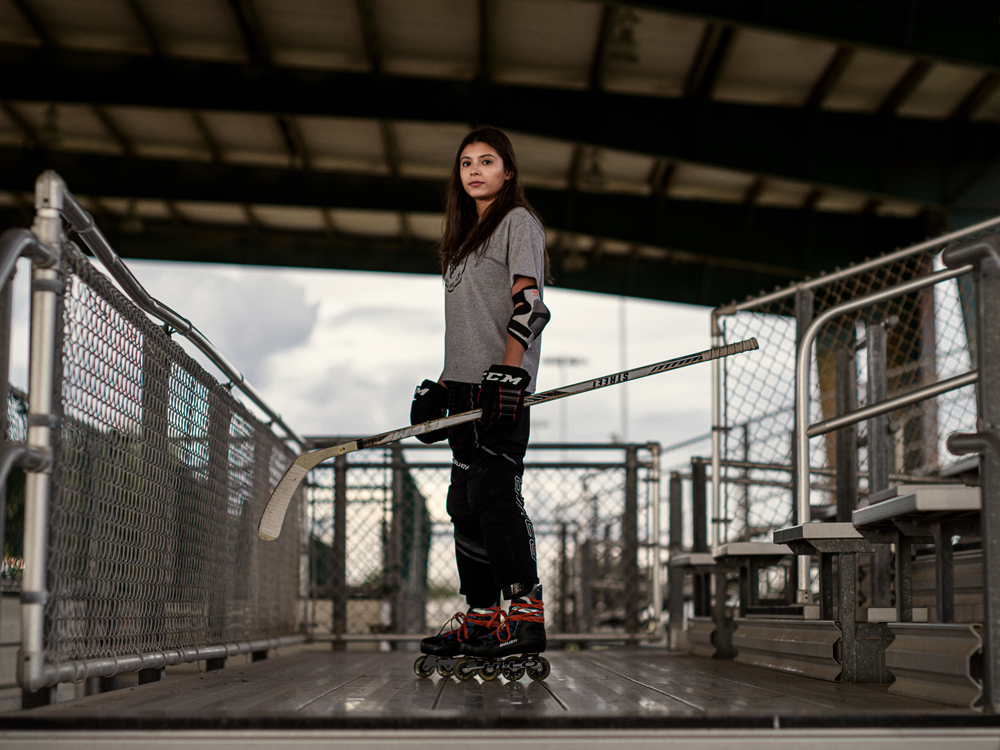
T
hough the Valley stretches across an international border, the region can’t be defined by either country. “It’s two cultures at once,” says Mata. “A lot of people speak Spanish, a lot of people have family in Mexico, they travel back and forth. … It’s really like two distinct cultures coming together to make another culture — the Valley culture. It’s Texas [and]it’s Mexico, all together.”
While fretting about the border has consumed the American news cycle for the past half-decade, that tension seems a world away for many in the Valley, says Mata, especially those who remember a time when families on either side felt even more connected than they do now. “Before the cartel wars in the late ’90s and 2000s got bad, it was very much [that]there wasn’t really a border,” says Arias, who’s lived in the Valley her whole life, on both sides of the Rio Grande. “The culture and community was: your family lives on one side of the river and your family lives on the other side, and you say hi to them every morning. Our cultures are very much intertwined.”
For the hockey lovers on the American side of the Valley, though, those deep bonds haven’t resulted in the embrace of the game they’ve seen in northern Mexico. For them, the sport’s growth has been far more strained. Craig Lewis has been there from the very beginning, the Peterborough native having arrived in south Texas in ’79. Back then, the hockey scene in the McAllen area was nonexistent. “I still remember watching the 1980 Olympics and nobody down here understood the magnitude of the U.S. beating Russia,” he remembers with a laugh. “I had no one to share that with.”
Plus, look for bonus breaking news episodes and interviews with some of the most interesting personalities in hockey.
He tried to spark some interest himself. By the early ’90s, he was organizing pick-up games, coaching his two boys and a few other kids in the area who tagged along until more quintessentially Texan sports pulled them away. But the efforts gained little momentum among those who weren’t already familiar with hockey, having played elsewhere.
Even the presence of a bona fide pro team did little to bring about lasting growth. The Central Hockey League’s Rio Grande Valley Killer Bees arrived in south Texas in 2003, filling a 6,500-seat arena regularly for a few years before fizzling out after nine seasons. A junior-A team of the same name sprouted up a year later, only to fold after a pair of seasons. A third iteration of the Killer Bees, another junior team, gave it a try a few years after that. It failed the same year it was founded.
The hits for the hockey community in south Texas just kept coming. In 2005, that outdoor rink in McAllen was built, Lewis having pushed for its approval for years. But the city opted to keep it under lock and key for paid rentals, despite Lewis’s repeated protests, limiting its use to those willing and able to pay to play. More recently, a warehouse in the area was converted to an ice rink, becoming a regular spot for the expats. It was permanently shuttered in March, days before Lopez and Co.’s rec league championship final, the pandemic rendering it too costly to keep afloat.
But even after all the starts and stops, the Valley’s hockey lovers refuse to give up. And in RGV Roller, Mata hopes he’s found the key to finally unlocking the region’s passion for the sport — not by mounting a grandiose plan to bring another pro team to south Texas or get a sprawling ice rink built in McAllen, but by implementing the simple, organic approach that allowed the game to take hold in Diaz Ordaz. “I think you grow hockey by giving hockey,” Mata says, “not by telling hockey people, ‘Hey, you should accept new people.’ I think new people just need to make their own path, and that [starts]by giving them the gift of hockey.” So, that’s what they’ve tried to do.
Their efforts resumed in the early months of 2021, a year after RGV Roller took its first steps, when Texas reopened. While Mata and his team were wary of the loosening restrictions, it did mean they could begin rekindling the fire they’d sparked 12 months prior. They soon found it had never really gone out. They began holding open skates twice a month, 20 to 30 kids and their parents filling the rink each time to take a spin around, shoot some pucks, and begin falling in love with the sport. They launched an adult roller league, their first season enough of a success that plans have been made for a second season to fill the second half of the year. And as Mata, Lopez and the rest of the local veterans started hitting the McAllen rink for that inaugural campaign each week, a funny thing happened: the stands started to fill, locals coming out to watch what would be akin to a run-of-the-mill beer league elsewhere in the country. McAllen’s mayor took in a game, they had frontline workers drop pucks for ceremonial faceoffs, and they finished the year by handing out a comically large championship trophy in front of a cheering crowd.
It’s come slowly, but the RGV Roller team has seen the impact of their focus on that grassroots approach. “We have this one little girl who hasn’t missed a single skate,” Mata says. “She went from just wearing the regular Rollerblades to a pair of hockey skates that she’s into now. She got a Mighty Ducks jersey.” Though the lingering pandemic has delayed their ability to dive headfirst into their lengthy list of plans — and prevented them from opening up the rink to full capacity — their next steps are plotted out: a slew of learn-to-skate and learn-to-play camps; an equipment bank to lend gear to kids who can’t afford it; a development league for new players, who can eventually move on to join Lopez and the other veterans; and an adopt-a-player program that will see each of those veterans mentor a younger member of the fledgling hockey community, coaching them and donating gear.
But while the seeds have been planted and the early returns suggest RGV Roller might just create something long-lasting in south Texas, Mata hasn’t lost sight of the bigger picture. “I see it almost as hockey’s last stand down here,” he says. “Because we had an ice rink, and we had a minor-league hockey team, that then turned into a junior hockey team, but those teams have left — years ago now. The ice rink closed. So, it kind of feels like we’re holding onto hockey by a thread, and I’m really trying to make sure there is a future for hockey here.”
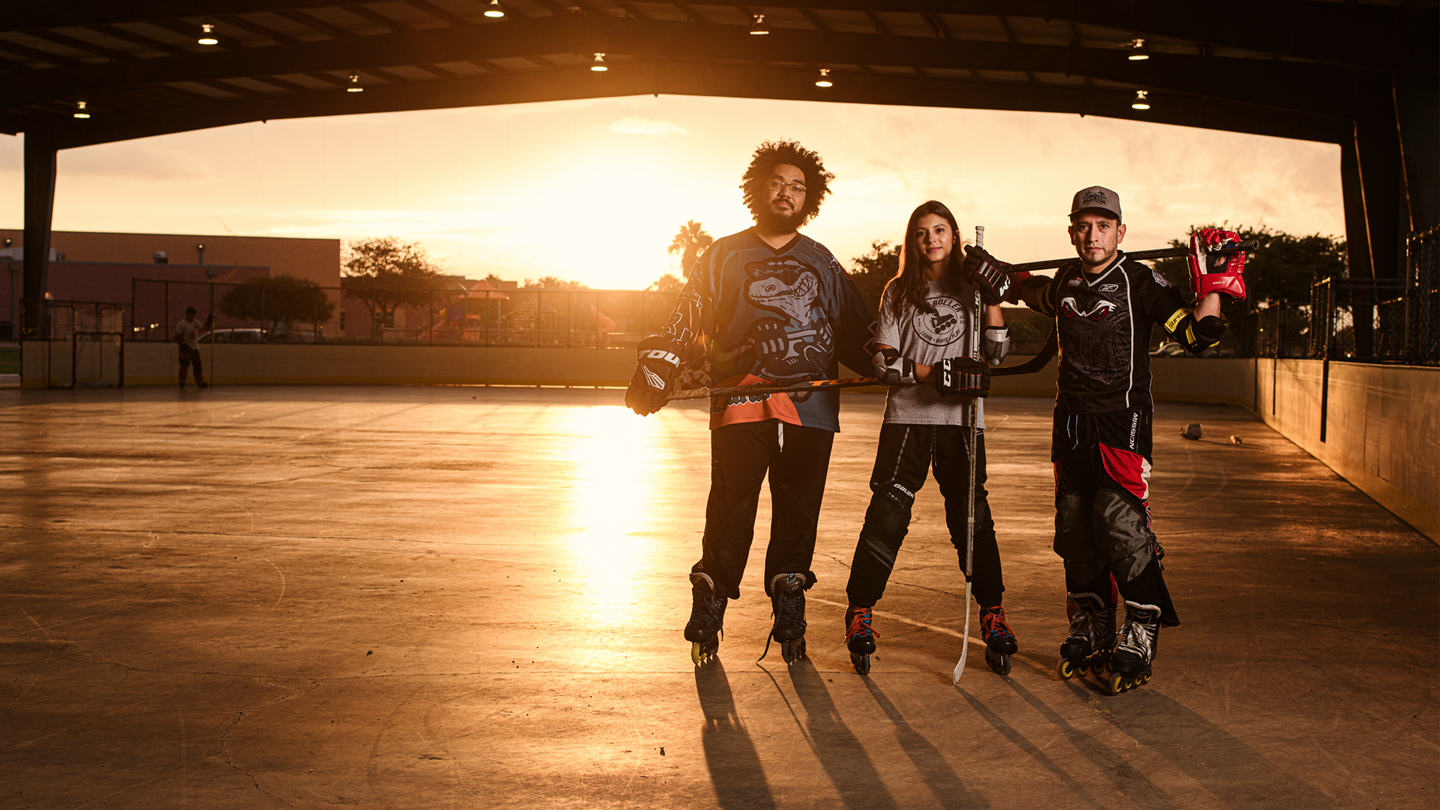
F
or Lopez, Mata, and the rest of the Valley’s hockey lovers, the endgame is a south Texas community still enamoured with the sport decades down the line. It’s a vision wherein hockey not only survives on the American side of the Valley, but thrives. But their efforts also mean something for the sport as a whole.
Step back and take stock and hockey’s need for growth is clear. Reaching out and finding new fans, new players, new communities to be part of the game is more than a nice-to-have at this point, it’s a necessity. To slow the waning of participation numbers, make up ground on the other already-mammoth North American sports, and diversify a sport sorely in need of new perspectives, hockey needs to expand its borders. And doing that is going to take engaging and embracing places like the Valley, that brim with untapped talent and potential.
The bridge to those communities is the same one that allowed all those kids in Diaz Ordaz to fall in love with the sport back in the day, and that’s delivering promising early returns in McAllen today: an environment where the game is easily accessible. “Unless we give equipment to young players and to low-income families, they’re just going to go play soccer, or they’re just going to go play basketball. That’s something that I know from my family,” Mata says. “They wanted me to play sports, but they didn’t want me to take all of the money for three kids to play one sport, for one year. It just doesn’t work that way.”
Growth must also come from making that investment in new communities, Mata continues, “because, otherwise, it’s going to be the same communities producing players. I mean, we’ve seen Auston Matthews come out of Arizona. We’ve seen Matt Nieto come out of California. There’s no reason that even low-income communities in these states can’t produce hockey players. And it’ll only help hockey grow.”
It’s not just the addresses of the rinks, though. It’s also about expanding what we think of as hockey, and who we think of as hockey players. It’s about showing communities of colour that they can be part of this game, too. “They might not think it’s for them, they might think, ‘Oh that’s an up-north sport, that’s a white sport’ … Yeah, if you turn on the TV, that’s how it looks. But hockey doesn’t only exist in the NHL, and it doesn’t even exist only on ice,” Mata says. “When I was a kid, I played a lot of street hockey, and it was definitely hockey to me, you know what I mean? It wasn’t kind of hockey, it was hockey.”
Those leading the big-picture efforts to grow the game also see value in focusing on roller hockey as a means of combatting the sport’s accessibility issues. “Those are all of the things that we have been speaking about — how do we make the sport more culturally available, more safe and welcoming in communities?” says Kim Davis, the NHL’s executive vice president of social impact, growth initiatives and legislative affairs. “We know that street and ball hockey and roller hockey are going to be some of the ways in which we can do that. … It’s low pressure, so you can dip your toe in the water to see if you like it. It starts as a low time commitment. It’s close to home, low travel. These are all of the perceived impediments, particularly for communities of colour, that hockey faces. And I think the idea of ball and street and roller hockey is a wonderful way to eliminate those impediments.”
What’s happened in the Valley — from RGV Roller all the way back to The Doctor and his Tamaulipas dream team — shows the potential of that approach. Of what can happen if space is made for newcomers. “It breaks down one of those myths about communities of colour, that because a community may be socio-economically disadvantaged, that they aren’t going to engage,” Davis says. “If you inspire a community and family to be part of something, and their kids are interested in it, they are going to find ways — through family collaboration, through communities working together — to provide the resources and to provide the access for the kids. And they’re going to consume the sport, so that builds fandom.”
Maybe one day, down the line, the gap between the Valley and the big leagues won’t be so great. Maybe the wild chapters authored so far — from The Mighty Ducks miracle in Diaz Ordaz to the roller revolution in McAllen — are just the beginning of a story that ends with their own Hollywood-esque ascent. What’s the harm in dreaming big? “There’s so much talent down here, and maybe it’s not junior or NHL professional talent, but at the same time, who knows?” Mata says. “If the resources were here, if we had a bigger hockey infrastructure, I think the sky would be the limit. … If you put a street hockey rink on every few blocks, and then every couple of towns has a roller rink, and then every region has an ice rink, I think you would see the farm system created organically.”
Lopez can see it, too. He need only look to how much things have already changed in the Valley since he was that kid shooting pucks into the night by himself to understand what could one day be possible. “We just grew up in a small community, [but]had we had the right focus, I believe more players would be trying out for the NHL from Mexico,” he says. If it seems unlikely, just look back at the sport’s roots, at other countries that once seemed unimaginable hockey hotbeds — until they weren’t. “Ten years from now, instead of looking across the ocean into Europe, and bringing players from Europe, we’re going to look to players from Mexico. Because 10 years from now, I believe it’s going to grow a lot,” Lopez says. “If the formula works over there in Canada, I don’t see why the formula wouldn’t work over here.”
But before they fully take on the loftier aspirations they have in mind — those visions of showing the hockey world that roller can be the key to growing the sport, to unlocking the potential in communities all over North America that have been underestimated and overlooked — RGV Roller has one central goal to focus on first: making sure the love of the game has room to bloom, flourish, and grow tall in the Valley.
“We’ve got to spread this sport here. We’ve got to get our beautiful community of colour involved,” says Arias. “Our area is really poor, the poorest in the state of Texas, across the entire U.S.-Mexico border. And that would be the dream, right? To get our community access to that. Because it’s something we’ve never had before.”
Josh Huskin/Sportsnet (5)



